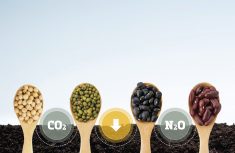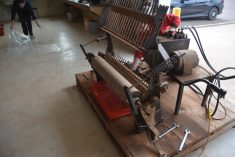Manitoba potato producers are growing a high-value horticulture crop with a hefty appetite for nutrients, particularly nitrogen.
But they must also consider infield conditions that can have a huge impact on what happens to that nitrogen. An untimely rain event could wash it through the root zone, making it unavailable. Soaked soils and warm temperatures can cause nitrogen to gas off into the atmosphere before the plants have a chance to soak it up.
Historically, growers managed this with split nitrogen applications, applying a second shot when they hilled their crops later in the season. But the latest research shows early hilling gives better tuber production and the latest equipment – GPS and autosteer – is allowing growers to get out earlier and earlier to hill the crops, says Susan Ainsworth, a production specialist with the provincial Agriculture Department.
Read Also

How much nitrogen can farmers really cut?
Manitoba fertilizer trials look for nitrification inhibitor sweet spot, to lower greenhouse gas emissions and cost without hurting yield.
“If you’re hilling a couple weeks after planting – really before the crop gets all the way out of the ground – you’re not really splitting your nitrogen application at all,” Ainsworth says.
DIFFERENT OPTION
These realities in the field are causing more potato growers to look at a well-understood, but not widely adopted, technique known as fertigation, – adding crop nutrients to irrigation water at the pivot pump.
“They need a tank, a pump and backflow prevention to make sure the nutrients don’t wind up contaminating the groundwater,” Ainsworth explained to the Manitoba Co-operatorduring a recent telephone interview. “The growers who are using fertigation are applying a UAN solution – 28-0-0.”
From a technical perspective, it’s straightforward. Assuming a grower already has the irrigation pivot in place, the equipment to add fertigation capability is relatively easy to source, install and operate. But getting the most from it always relies on skill and knowledge, Ainsworth says.
“It definitely allows growers to better manage their nitrogen,” Ainsworth says. “But you can’t apply simple rules like ‘if you plant on this date, you must apply x pounds of nitrogen on this date.’ There are a lot of variables that go into determining how much to apply and when. It really is all about being out, watching your crop, maybe taking petiole samples for testing, and then making that decision.”
Because potato crops are irrigated regularly throughout the season, growers can time their applications using fertigation much more closely to actual crop needs.
MORE BANG FOR THE BUCK
Wade Gerber, a potato agronomist with Simplot, based in Grand Forks, North Dakota, told last winter’s Manitoba Potato Days meeting that most growers in the region are still applying between 85 and 100 per cent of their nitrogen in two or three early-season applications, and expressed concern that growers are failing to get “the best bang for the buck.”
He told the meeting that in a worst-case scenario growers can be forced to reapply. A reapplication would run a 500-acre potato operation another $17,000.
During the same session, three Manitoba growers, Dennis Suderman, Sheldon Wiebe and Brent Metcalfe, talked about their experiences using fertigation. Suderman told the meeting he used less nitrogen on his operation in the western part of the Red River Valley, had healthier plants and improved his overall quality. He plans to expand its use.
Metcalfe has been using the technique on his Treherne-area operation since 2006, and he said he thinks fertigation reduced his disease pressure in 2010 and maximized tuber production, rather than growing foliage.
He told producers that several years of experience have convinced him that the best strategy is to taper off applications throughout the season, with the last application going on by August 1.
BALANCING ACT
MAFRI’s Ainsworth says the grower challenge amounts to a delicate balancing act. Too much nitrogen early in the season will encourage top growth and hamper tuber set, but too much stress can hinder production too.
“You want to get just the right amount of top growth, and get your crop to set tubers early,” Ainsworth said. “You don’t want to delay set and feed foliage. It really is about using all those tools at your disposal to test your crop and watching it in the field. There’s a bit of an art to this. You want to basically spoon-feed the N to your crop, and give it to it just when it needs it.”
That might seem like a daunting challenge, but once growers gain some first-hand experience, they’re generally sold on the system, she said.
“I think it can be a little bit intimidating the first time, but there are a lot of benefits,” said Ainsworth. “One of the biggest benefits is the quality of the crop – with potatoes it’s all about consistent conditions during the growing season, and fertigation really helps promote that.”














